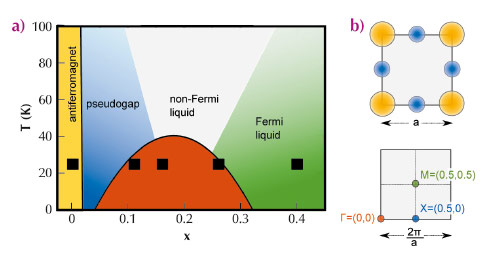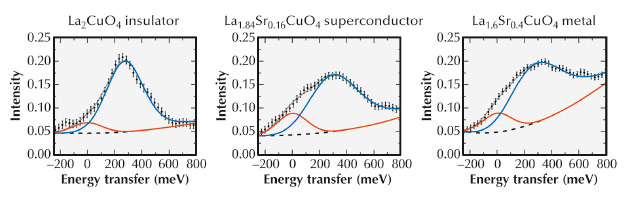- Home
- Users & Science
- Scientific Documentation
- ESRF Highlights
- ESRF Highlights 2013
- Electronic structure and magnetism
- Persistent magnetic excitations in superconducting and non-superconducting La2-xSrxCuO4
Persistent magnetic excitations in superconducting and non-superconducting La2-xSrxCuO4
The phenomenon of high-temperature superconductivity (HTS) in the copper-oxygen-based or cuprate materials has been puzzling researchers for over a quarter of a century. A key question relates to the cause of the disappearance of superconductivity in the highly doped or overdoped cuprates. One of the most intensely studied proposals to explain HTS postulates pairing by the exchange of magnetic excitations [1] and it was therefore suggested that HTS disappears in the overdoped cuprates because magnetic excitations are completely suppressed by doping [2]. We used resonant inelastic X-ray scattering (RIXS) measurements to show that some magnetic excitations actually persist in the overdoped cuprates. The destruction of HTS with overdoping is therefore not caused by the simple overall disappearance of magnetic excitations, a fact that must now be explained in any successful theory of HTS.
 |
|
Fig. 100: a) A schematic phase diagram for La2-xSrxCuO4 as a function of the doping level, x. The doping levels of the samples studied here are marked by black squares. b) Top, the basic structural unit of the cuprates: a CuO2 plaquette with Cu atoms in orange and O atoms in blue separated by distance a = 3.8 Å. Bottom, the reciprocal lattice with high symmetry points marked and labelled in reciprocal lattice units (r. l. u.). |
When one examines the phase diagram of the cuprate La2-xSrxCuO4, as shown in Figure 100a, an exciting opportunity to gain insights into HTS presents itself. Superconductivity is seen to disappear at high dopings (x > 0.3), where the sample shows metallic behaviour. In conventional superconductors, a higher electronic density of states usually increases the superconducting transition temperature, so identifying the crucial change that destroys HTS in the overdoped cuprates has great potential to provide insights into the HTS mechanism. This motivated many neutron scattering experiments, where researchers observed that the intensity of the magnetic excitation they measured was reduced as the doping concentration (x) was increased, and by x = 0.3 the magnetic excitations appear to have effectively disappeared [2]. As a consequence of this, it has been argued that the disappearance of HTS in the overdoped cuprates is simply because there are no magnetic excitations available to mediate the pairing [1-2].
Due largely to the extremely high brightness of synchrotron sources, resonant inelastic X-ray scattering (RIXS) is a highly sensitive probe of magnetic excitations. We used RIXS to measure the magnetic excitations for samples with doping levels that span the whole phase diagram of La2-xSrxCuO4. The example spectra, shown in Figure 101, demonstrate that magnetic excitations persist in the heavily overdoped cuprates – proving that these samples are not simple non-magnetic metals.
 |
|
Fig. 101: Example spectra of La2-xSrxCuO4 for insulating, superconducting and metallic (non-superconducting) samples. The magnetic response, outlined in blue, appears with similar energy and intensity in all samples. Only the width changes significantly. The additional intensity seen at high energy transfers results from a broadening of the orbital excitations, which lie at 1-3 eV in energy. |
The apparent contradiction between the persistent intensity measured in the RIXS experiment and the reduction of intensity measured by neutrons, can be resolved by noting that each technique focuses on different regions of the Brillouin zone, shown in Figure 100b. The RIXS measurements were taken along the (0,0) to (0.5, 0) symmetry line. In this region of reciprocal space, the intensity of the magnetic excitations is below the signal-to-noise ratio of current inelastic neutron scattering experiments on doped cuprates. Instead, inelastic neutron scattering experiments focus on the higher intensity excitations around (0.5, 0.5). Together, the RIXS and neutron scattering results show that doping does not uniformly rescale the magnetic excitation spectrum of the cuprates, rather the changes in the spectrum vary significantly depending on which region of the Brillouin zone is studied. Our results show that the demise of HTS in the overdoped cuprates is not due to dramatic changes in the high-energy magnetic excitations, as these remain roughly constant as the doping (x) increases. The change in the superconducting transition temperature must, therefore, be driven by other factors. It might be that the low-energy magnetic excitations around (0.5,0.5) drive the formation of HTS, as these excitations, unlike the high energy excitations studied here, are known to change dramatically in the overdoped cuprates.
Principal publication and authors
M.P.M. Dean (a), G. Dellea (b), R.S. Springell (c), F. Yakhou-Harris (d), K. Kummer (d), N.B. Brookes (d), X. Liu (e,a), Y.-J. Sun (e,a) J. Strle (f,a), T. Schmitt (g), L. Braicovich (b), G. Ghiringhelli (b), I. Bozovic (a) and J.P. Hill (a), Nature Materials 12, 1019–1023 (2013).
(a) Department of Condensed Matter Physics and Materials Science, Brookhaven National Laboratory, Upton, New York (USA)
(b) Dipartimento di Fisica, Politecnico di Milano (Italy)
(c) Interface Analysis Centre, University of Bristol (UK)
(d) ESRF
(e) Beijing National Laboratory for Condensed Matter Physics, and Institute of Physics, Chinese Academy of Sciences, Beijing (China)
(f) Department for Complex Matter, Jozef Stefan Institute, Jamova, Ljubljana (Slovenia)
(g) Swiss Light Source, Paul Scherrer Institut, Villigen (Switzerland)
References
[1] D.J. Scalapino, Rev. Mod. Phys. 84, 1383 (2012).
[2] S. Wakimoto et al., Phys. Rev. Lett. 98, 247003 (2007).



